
views
Deciphering the Prescription
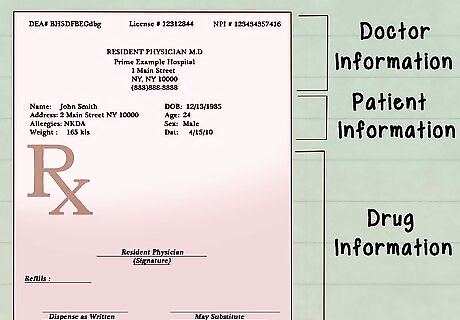
Know the parts of the prescription. There are certain pieces of information that your doctor will always include on a prescription. The doctor's professional information, such as her name, address, and phone number, will be at the top of the form. In the upper section of the prescription sheet, there will be a place for your name, your age or birth date, your address, and the date the prescription is given to you. Below this, your doctor will write the relevant drug information. This will include the medicine she is prescribing, the dosage, how many pills to take per dose, and how each dose should be taken. There will also be information for the pharmacist about how much of the medicine to give you when your fill it the first time and how many times you can refill it. Your doctor will also sign and date the bottom to verify that it was prescribed by a professional. If the prescription is for a controlled substance -- one that the government has decided has the potential for "abuse or dependence," such as morphine or methadone -- certain additional requirements must be included. The form must stipulate the number of refills (if any) and must be written in ink or typewritten. It must be manually signed by the prescribing physician. The prescription form will vary depending on what your doctor uses. For example, there may be boxes that she fills in for number of refills or it may be generated by a computer. Regardless of how it is written, the same basic information must always be written on the prescription form. Many practitioners will now send prescriptions electronically to the pharmacy of your choice. This is considered easier and more convenient by many practitioners, and also may reduce the chance of an error.
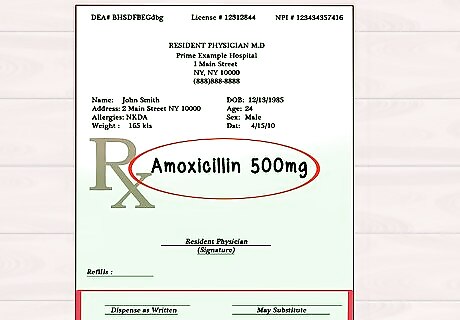
Understand how to read the drug name. The main purpose of your prescription is to let the pharmacist know what drug you need in what concentration. Don't worry if you don't recognize the name of the drug. Typically, your doctor will write out the generic name for the drug. This is because the brand names for drugs can be spelled similarly and it might cause confusion or error at the pharmacy. If your doctor wants you to take a particular brand of medicine, she can write a note to your pharmacist that indicates this need. It will say something along the lines of "no substitution" or "brand name medically necessary." There might also be a box on the prescription somewhere that indicates if your doctor prefers the generic or brand name version of the medication.
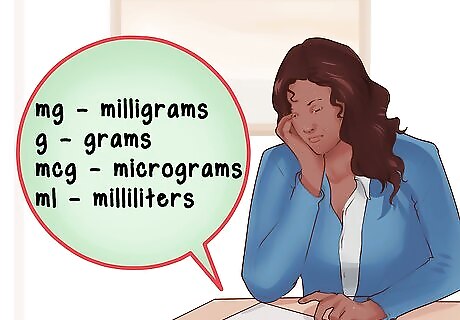
Read the dosage information correctly. The number behind the name of the drug is the amount you should take per dose. It will vary depending on the type of medication that you are taking. For example, most pills will be in milligrams, but measurements can also appear in grams or micrograms. The doctor may write out the full word for this or she may write the abbreviations. The abbreviation for milligrams is mg, g is for grams, and mcg is for micrograms. If you are taking a liquid medicine or medicine by syringe, the dosage information will be in milliliters. The abbreviation for this is ml.

Learn the abbreviations for dosage methods. On your prescription, the line underneath the drug and dosage concentration will be the instructions on how many doses you should take at one time and the method that should be used to take the medication. The main problem with being able to read these is that typically, doctors use medical shorthand, some based on Latin phrases, that you are not able to understand unless you have a medical background. For the number of doses to take at one time, the doctor might write an i for the number of doses you need to take at a time. For example, if you are supposed to take 3 pills per dose, your doctor might write iii on your prescription. She may also write sig, which means to take it as it is labeled to be taken. There are other doctors, however, who will just write what you are supposed to have, such as "1 tab," which indicates how much you should take. After the amount per day, the doctor will write how to administer your medication. Each method has an abbreviation that is Latin based. Po means to take it orally, pr means per rectum or suppository, sl means sublingual or under the tongue, IV means injected into the vein, IM means injected into the muscle, and SQ means subcutaneous or under the skin.
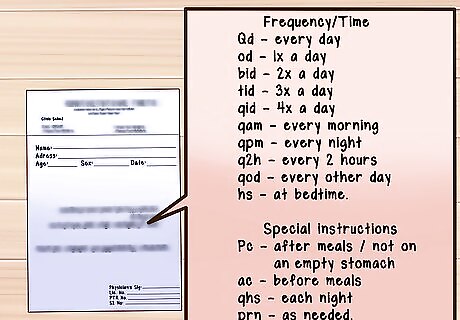
Decipher how you should take the medication. Next to the dosage methods, the doctor will write an abbreviation for how often you should take your medication. This describes the number of times a day or week you should take your medication. Next to this, she will write any special circumstances under which you should take the medication. This will indicate things such as the need to take the medication with food. The description of how often you should take your medicine is abbreviated using Latin phrases just like the method. Qd means every day, od means once daily, bid means twice a day, tid means three times a day, and qid means four times a day. The abbreviation qam means every morning, qpm means every night, q2h means every 2 hours, qod means every other day, and hs means at bedtime. Any special instructions are also abbreviated based on Latin phrases. Pc means after meals or not on an empty stomach, ac means before meals, qhs means each night, and prn means as needed. Some doctors will write how often it should be taken instead, such as writing "daily" next to the dosage information. For controlled substances such as pain killers, she may write out the reason for taking the medication, such as the phrase "pain" if you need certain medications after surgery or for a chronic condition. Interpret prescription abbreviations to refamiliarize yourself with work. "When returning to my job at a pharmacy after leaving, I was very rusty on prescription shorthand. This article’s breakdown of Latin abbreviation meanings, dosage numbers, and more was an invaluable refresher to get back up to speed interpreting scripts." - Jessica B. Clarify ambiguous directions written on prescriptions. "I always struggled reading the brief, abbreviated directions on prescriptions. The terminology and illegible handwriting confused me. By clearly laying out the meanings behind this medical shorthand, this guide made deciphering even the messiest doctor’s orders simple." - Sarah C. Use a prescription terminology primer to aid nurse training. "Learning pharmacology as a student nurse was challenging, especially making sense of abbreviations on scripts. The article’s prescription terminology translations aided my training tremendously. My test scores showed it!" - Kimberly S, Ask better medication questions by understanding the prescription background. "I used to just take prescriptions from my doctor without much explanation of what they meant. This overview helped me understand abbreviations and information included. Now I know what questions to ask at my appointments about new medications." - Mathilda Y. We want to hear from you! Advice from our readers makes our articles better. If you have a story you’d like to share, tell us here.

Look for refills. Your doctor may authorize a certain number of refills for your prescription without needing you to come in for another examination or follow-up.
Asking Questions

Write out your questions. Before you go to the doctor, you should have some questions ready in case you get prescribed medication. You should ask about the medication you are taking and all the details involved in its administration. This includes questions about the name of the medication, how often you are supposed to take it, the manner in which to take it, what disease the medication is treating, and if there are any side effects you should expect to have. You can also ask about what to do if you miss a dose and when you should stop taking the medication. It's a good idea to write these out in advance so you don't forget them. You might also want to ask what taking the medicine will accomplish, if there is a less expensive alternative, or if there are any interactions with other prescribed or over the counter medications, dietary supplements, foods, or herbal supplements.
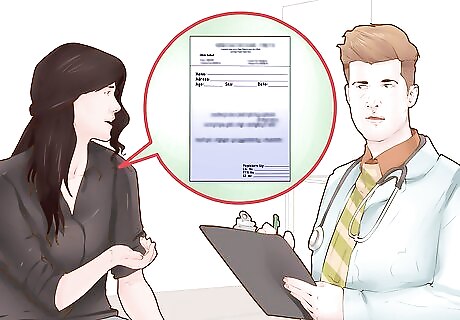
Ask for an explanation of the prescription. When you visit your doctor, if you are not exactly sure how to read the prescription you are given, you can ask them to explain their instructions for the medication before you leave the office. Use the questions you prepared before you went to the office to understand more about your prescription. Make sure you fully understand any terms they use or any descriptions that you may not know the meaning of. Make sure you write down the answers that give you so you will be able to compare this with what you get from the pharmacy. This way you make sure you are always taking the right medication in the right doses.
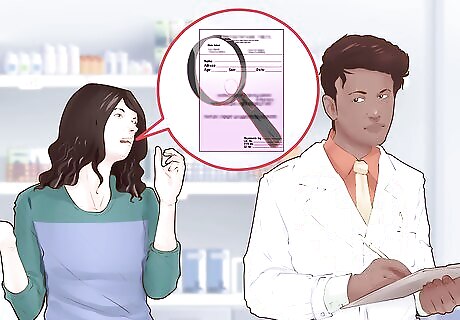
Request that the pharmacist review the prescription. One way to make sure that all the right procedures are followed in regards to your prescription is to have your pharmacist review it when you drop it off and when you pick it up. Mistakes can take place when a pharmacist reads the directions differently than what the doctor intended. You can help prevent dangerous medication errors by double checking and asking the pharmacist to verify the prescription with your physician. If you have any questions about the prescription or the medication, ask your pharmacist.

Review the information your pharmacist gives you. Once you get your prescription filled, you will get a pamphlet from the pharmacist that explains the medication you are taking, what side effects may occur, and many other medicine intricacies that you may have questions about it. The pharmacist will usually offer to explain the medication and answer any lingering questions you have about your medications. If you experience side effects or interaction effects, you should call your health care provider immediately to report them and ask for a confirmation of your intended prescription, as well as further instructions for taking the medication.

















Comments
0 comment